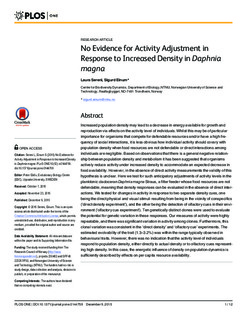| dc.contributor.author | Sereni, Laura | |
| dc.contributor.author | Einum, Sigurd | |
| dc.date.accessioned | 2016-01-26T08:15:13Z | |
| dc.date.accessioned | 2016-04-06T10:29:38Z | |
| dc.date.available | 2016-01-26T08:15:13Z | |
| dc.date.available | 2016-04-06T10:29:38Z | |
| dc.date.issued | 2015 | |
| dc.identifier.citation | PLoS ONE 2015 | nb_NO |
| dc.identifier.issn | 1932-6203 | |
| dc.identifier.uri | http://hdl.handle.net/11250/2384250 | |
| dc.description.abstract | Increased population density may lead to a decrease in energy available for growth and reproduction via effects on the activity level of individuals. Whilst this may be of particular importance for organisms that compete for defendable resources and/or have a high frequency of social interactions, it is less obvious how individual activity should covary with population density when food resources are not defendable or direct interactions among individuals are negligible. Based on observations that there is a general negative relationship between population density and metabolism it has been suggested that organisms actively reduce activity under increased density to accommodate an expected decrease in food availability. However, in the absence of direct activity measurements the validity of this hypothesis is unclear. Here we test for such anticipatory adjustments of activity levels in the planktonic cladoceran Daphnia magna Straus, a filter feeder whose food resources are not defendable, meaning that density responses can be evaluated in the absence of direct interactions. We tested for changes in activity in response to two separate density cues, one being the direct physical and visual stimuli resulting from being in the vicinity of conspecifics (‘direct density experiment’), and the other being the detection of olfactory cues in their environment (‘olfactory cue experiment’). Ten genetically distinct clones were used to evaluate the potential for genetic variation in these responses. Our measures of activity were highly repeatable, and there was significant variation in activity among clones. Furthermore, this clonal variation was consistent in the ‘direct density’ and ‘olfactory cue’ experiments. The estimated evolvability of the trait (1.3–3.2%) was within the range typically observed in behavioural traits. However, there was no indication that the activity level of individuals respond to population density, either directly to actual density or to olfactory cues representing high density. In this case, the energetic influence of density on population dynamics is sufficiently described by effects on per capita resource availability. | nb_NO |
| dc.language.iso | eng | nb_NO |
| dc.publisher | Public Library of Science | nb_NO |
| dc.rights.uri | http://creativecommons.org/licenses/by/4.0/ | |
| dc.title | No Evidence for Activity Adjustment in Response to Increased Density in Daphnia magna | nb_NO |
| dc.type | Journal article | nb_NO |
| dc.type | Peer reviewed | nb_NO |
| dc.date.updated | 2016-01-26T08:15:13Z | |
| dc.source.volume | 10 | nb_NO |
| dc.source.journal | PLoS ONE | nb_NO |
| dc.source.issue | 12 | nb_NO |
| dc.identifier.doi | 10.1371/journal.pone.0144759 | |
| dc.identifier.cristin | 1322299 | |
| dc.description.localcode | © 2015 Sereni, Einum. This is an open access article distributed under the terms of the Creative Commons Attribution License, which permits unrestricted use, distribution, and reproduction in any medium, provided the original author and source are credited. | nb_NO |

